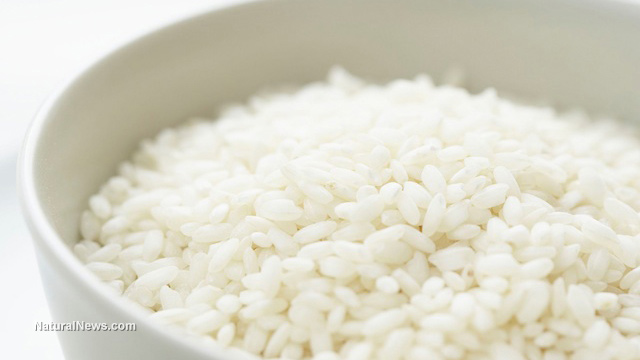New Consumer Report: Just one weekly serving of rice pasta could put your baby at risk for arsenic poisoning
Wednesday, November 19, 2014 by: Julie Wilson staff writer
Tags: arsenic, rice pasta, cancer

- Newly released JFK files reveal Pentagon's role in creating Lyme disease and covid in the same lab
- Trump's greatest betrayal so far: Accelerating Middle East wars, silencing dissent, and serving Zionist masters
- Trump nominates VACCINE ZEALOT Susan Monarez to lead the CDC, sidelining RFK Jr.'s reform efforts
- The hidden dangers in your kitchen: How cooking methods impact diabetes, cancer and aging
- STARDUST, a secretive Israeli-US startup, plans risky solar geoengineering experiment to BLOCK OUT THE SUN
- DEADLY DECEPTION: How COVID vaccines increased mortality rates and why authorities hid the truth
- Arkansas embraces medical freedom with landmark ivermectin law
- Lab leak confirmed? Boris Johnson's stunning reversal on COVID origins sparks global debate
- Analysis: The coming economic collapse, a mass uprising and Trump's three secret weapons to halt the growing revolt
- CDC finally halts $11 billion COVID funding scam as health officials admit the ‘pandemic’ was a fraud
- Home gardening for preppers: A beginner's guide to growing your own food
- The forgotten hormone hero: How vitamin C quietly balances mood, stress and reproductive health
- Festive flavors: The sweet history, nutritional profile and health benefits of pecan pie
- Elon Musk: Aliens could be here on Earth RIGHT NOW
- Dr. Mike Yeadon releases 15-minute testimony - WATCH - about genocidal intent of COVID “vaccines”
- California's social media censorship law struck down: A victory for free speech or a threat to online safety?
- YouTube’s double standard: CEO defends censorship while claiming free speech champion status
- Sugarcane extract superior to cholesterol-lowering drugs?
- Newly released JFK files reveal Pentagon's role in creating Lyme disease and covid in the same lab
- Elon Musk: Aliens could be here on Earth RIGHT NOW
- Reclaim your health: How midlife exercise reverses years of inactivity
- Trump reverses course on Gaza plan, says “nobody is expelling Palestinians”
- EPA advisor admits the agency is funneling billions to climate groups ahead of Trump’s return to White House
- Big Pharma's $8 Billion bribery scheme exposed: how doctors are pushed to prescribe junk science, not heal
- Space war brewing? Russia threatens to destroy Starlink satellites
- A lack of integrity in Academia: Harvard professor found GUILTY of fraudulent research to promote CRT theory
- Survival 101: Effective EMF blocking techniques
- Rep. Nancy Mace introduces bill to ban biological males from female facilities on federal property
- Mike Adams Sermon 66: God will DESTROY ISRAEL for its wickedness
- Pilots report mysterious lights 'moving at extreme speeds' across Oregon skies
- 5 Simple steps to boost your brainpower: How to strengthen executive function in a distracted world
- Historian warns Israel may be entering an “IRREMEDIABLE DECLINE”
- Florida takes a stand: DeSantis proposes permanent ban on mRNA vaccine mandates
- RFK Jr.'s SSRI antidepressant investigation sparks liberal meltdown, exposes Big Pharma's dangerous game
- OpenAI whistleblower who dissented against how the company trained ChatGPT found dead
- Sugarcane extract superior to cholesterol-lowering drugs?
- EPA advisor admits the agency is funneling billions to climate groups ahead of Trump’s return to White House
- The Health Ranger releases “Vaccine Zombie” song and music video, using AI-animated zombies for the music video
- California's social media censorship law struck down: A victory for free speech or a threat to online safety?
- Dr. Mike Yeadon releases 15-minute testimony - WATCH - about genocidal intent of COVID “vaccines”
- The pandemic as a tool for INDOCTRINATION: Understanding “The Indoctrinated Brain” by Dr. Michael Nehls
- Mike Adams releases country western hit single: Goin’ Back in Time is Comin’ Home
- Mike Adams releases music poetry sensation: A Child of God
- RFK Jr. clears key hurdle: Sen. Susan Collins backs controversial HHS nominee, signaling a new era for health policy
- Florida takes a stand: DeSantis proposes permanent ban on mRNA vaccine mandates
- Unpacking the Lies That We’ve Been Fed – new song and music video released by Mike Adams, the Health Ranger
- Mike Adams releases new song and music video: Nothing More Disgusting Than a Globalist
- Congratulations to the FULLY UNVACCINATED as you resisted the COVID-19 PROPAGANDA MACHINE fueled by over $100 BILLION
- “Why we influenced the 2020 elections”: Facebook files reveal the coordinated effort to bury the Hunter Biden laptop story
- Michigan sheriff announces criminal investigation into 2020 election crimes, Dominion Voting Systems
- Israeli soldiers accused of even more torture and abuse in the West Bank
- Migrants are taking advantage of recent hurricanes to scam residents and loot their homes
- House Intelligence Committee calls for the ARREST and PROSECUTION of Dr. Anthony Fauci
- Peter Rost exposes Big Pharma corruption in his book “The Whistleblower: Confessions of a Healthcare Hitman”
- Red Cross issues warning to stop blood plasma donations from vaccinated people
- Scientists confirm: GENIUS brain function can be spontaneously unleashed in humans without any apparent cause
- EPA advisor admits the agency is funneling billions to climate groups ahead of Trump’s return to White House
- HYSSOP: What research reveals about the health benefits of this ancient holy herb
- Two containers with completed ballots fall out of truck in Florida
- Fully vaccinated about to see “tsunami” of illness and death, warns virologist
- Global leaders unite to clamp down on “misinformation” with UN-backed Cascais Declaration
- BREAKING: 2025 NDAA authorizes mandatory military draft of WOMEN across America… as Pentagon pursues global NUCLEAR war with both Russia and China at the same time
- Michael Yon warns of a ZIONIST TAKEOVER in Trump’s second administration
- BOMBSHELL: DNA testing kits are a SCAM to develop ethnic-specific bioweapons
- Ozempic and Wegovy weight loss drugs are injectable LIZARD VENOM PEPTIDES that may unleash a devastating wave of organ failure… side effects align with symptoms of SNAKE BITES
- Israeli soldiers accused of even more torture and abuse in the West Bank
- These 13 countries just signed an agreement to engineer a global FAMINE by destroying food supply
- NASA admits that climate change occurs because of changes in Earth’s solar orbit, and NOT because of SUVs and fossil fuels
- RFK Jr. clears key hurdle: Sen. Susan Collins backs controversial HHS nominee, signaling a new era for health policy
- Sermon 30: How Jesus reveals Caesar’s FAKE CURRENCY and FALSE AUTHORITY
- Coriander seeds: Ancient medicine backed by modern science
- Arizona officials claim Maricopa County needs 10-13 days to tabulate results of the election
A 2012 investigation by Consumer Reports discovered "significant levels" of inorganic arsenic, a known carcinogen, in a range of rice products including organic, conventional and gluten-free rice.
Inorganic arsenic found in most rice products
More than 200 rice products were tested, with inorganic arsenic showing up in nearly every "...product category along with organic arsenic, which is less toxic but still of concern." Organic arsenic is considered to be less or nontoxic to humans and is naturally occurring within the earth's crust.Despite warnings from the U.S. Environmental Protection Agency (EPA) that there are no "safe" levels of exposure to inorganic arsenic, federal limits regarding arsenic levels only apply to drinking water and not food products.
However, in July 2013 the U.S. Food and Drug Administration (FDA) proposed to limit arsenic in apple juice following widespread consumer concern after Dr. Oz and Consumer Reports found that 10 percent of juice samples from five brands tested positive for arsenic levels that exceeded federal drinking water standards.
New research suggests eating a variety of grains to avoid exposure to arsenic
The most recent testing performed by Consumer Reports provides new information on the risk of arsenic exposure through rice cereal and other rice products. After reviewing data released by the FDA in 2013 on the inorganic arsenic content of more than 650 processed rice-containing products, the monthly magazine found that rice cereal and rice pasta had more inorganic arsenic compared with their data from 2012.The new results concluded that just "one serving of either could put kids over the maximum amount of rice we recommend they should have in a week. Rice cakes supply close to a child's weekly limit in one serving."
The report also found rice drinks to be high in arsenic, recommending that children under five avoid them at all costs, drinking milk instead. Consumer Report's 2012 recommendation that babies eat no more than one serving of infant rice cereal per day, instead adding a variety of grains to their diet, remained unchanged with the new results.
Regular arsenic exposure can increase your risk for bladder, lung and skin cancer
Aside from increasing your risk for developing numerous cancers, regular exposure to small amounts of arsenic can cause heart disease, type 2 diabetes and affect the immune system of unborn babies.Consuming grains like millet, buckwheat, basmati rice and quinoa can lower your exposure to arsenic, according to recent data, but white rice grown in Texas, Arkansas or Louisiana had the highest levels of arsenic. Brown rice also had high levels as arsenic accumulates in the grain's outer layers, which are removed during the white rice process.
"White basmati rice from California, India, and Pakistan, and sushi rice from the U.S. on average has half of the inorganic-arsenic amount of most other types of rice, "states the report.
Gluten-free grains amaranth, buckwheat, millet, and polenta or grits had negligible levels of inorganic arsenic. Quinoa (gluten-free), bulgur, barley and faro all had low levels as well. Researchers note that some samples of quinoa had "quite a bit more" arsenic, but levels were still low compared to rice.
It may be possible to reduce your exposure to arsenic by thoroughly rinsing any type of raw rice before cooking, and using a ratio of 6 cups water to 1 cup of rice, making sure to drain any excess water before eating. Previous research suggests rinsing raw rice removes about 30 percent of the rice's inorganic arsenic content.
Sources:
http://www.consumerreports.org
http://consumerreports.org
http://www.consumerreports.org
http://www.greenerchoices.org[PDF]
http://www.consumerreports.org
http://www.foodsafetynews.com
Arsenic at FETCH.news
Get independent news alerts on natural cures, food lab tests, cannabis medicine, science, robotics, drones, privacy and more.
Take Action: Support Natural News by linking to this article from your website
Permalink to this article:
Embed article link: (copy HTML code below):
Reprinting this article:
Non-commercial use OK, cite NaturalNews.com with clickable link.
Follow Natural News on Facebook, Twitter, Google Plus, and Pinterest
Science News & Studies
Medicine News and Information
Food News & Studies
Health News & Studies
Herbs News & Information
Pollution News & Studies
Cancer News & Studies
Climate News & Studies
Survival News & Information
Gear News & Information
News covering technology, stocks, hackers, and more



"Big Tech and mainstream media are constantly trying to silence the independent voices that dare to bring you the truth about toxic food ingredients, dangerous medications and the failed, fraudulent science of the profit-driven medical establishment.
Email is one of the best ways to make sure you stay informed, without the censorship of the tech giants (Google, Apple, Facebook, Twitter, YouTube, etc.). Stay informed and you'll even likely learn information that may help save your own life."
–The Health Ranger, Mike Adams













































